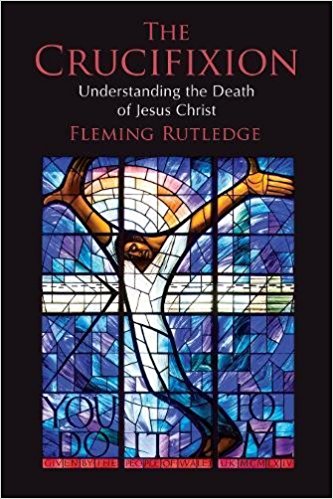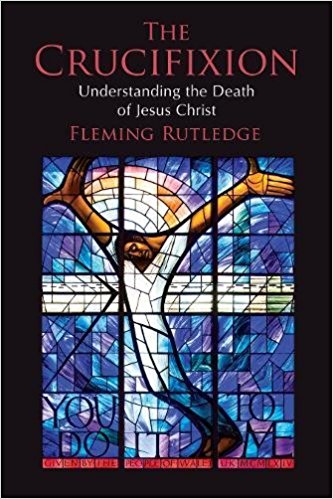The Crucifixion: Understanding the Death of Jesus Christ

A Denver Journal Book Review by Denver Seminary Professor of Applied Theology and Biblical Preaching Scott Wenig

Fleming Rutledge. The Crucifixion: Understanding the Death of Jesus Christ. Grand Rapids: Eerdmans, 2017. 696 pp. $30.00. ISBN: 978-0-8028-7534.
Over thirty years ago evangelical scholar and pastor John Stott published what many consider his magnum opus, The Cross of Christ. In view of a surprising lack of contemporary works on the subject, either scholarly or popular, Stott dedicated himself to producing a monograph that covered the biblical text, incorporated solid amounts of historical theology and was relevant to the modern world. Given its depth, breadth and wide acclaim, he was definitely successful in his task. For most of the past three decades The Cross of Christ, published by Inter Varsity Press, has been the standard bearer for evangelicals on the doctrine of the atonement.
But in late 2015 Eerdmans published a book that may now rival Stott’s work on this central focus of the Christian faith. Written by noted Episcopal pastor and preacher Fleming Rutledge, The Crucifixion: Understanding the Death of Jesus Christ, is nothing short of a biblical and theological tour-de-force. In the Introduction Rutledge states that it took her sixteen years to write the book. After reading the text as well as the innumerable footnotes and perusing the twenty-three page bibliography, I’m not at all surprised. She also notes that she’s been thinking about the subject since she was thirteen years old, revealing that this work is, in many ways, the consummate achievement of a lifetime.
The book is divided into two main sections. In part one, appropriately titled The Crucifixion, Rutledge asks the singularly crucial question: Why crucifixion? Why did Jesus, as the incarnate Son of God, die in such a horribly obscene manner? Given its utterly despicable nature and the fact that the Romans both perpetuated its practice against all their enemies both real and imagined, and also legally protected their own citizens from its degradations, why did God the Father allow His only begotten Son to be brutalized and executed in this way?
In my view her answer is refreshingly honest in both its biblical focus and grasp of historical reality. First, Rutledge argues that humanity is far worse off than we think or imagine. The macro sins of genocide, unmitigated warfare, and unending oppression combine with all of our seemingly innocuous personal failures such as pride, greed, lust, and spiritual indifference to demonstrate that as a species we are totally depraved. Years ago, the great English author G.K. Chesterton, noted that depravity was the one empirically verifiable biblical doctrine. Rutledge proves him right with one depressing anecdote after another, demonstrating that we are spiritually corrupt and morally flawed creatures who insist on rebelling against our Creator and preying on our fellow man. As she notes…
In his death, Paul declares, Jesus was giving himself over to the Enemy – to Sin, to its ally the Law, and to its wage, Death (Romans 6:23, 7:8-11). This was his warfare. That is one of the most important reasons – perhaps the most important – that Jesus was crucified, for no other mode of execution would have been commensurate with the extremity of humanity’s condition under Sin. (her italics, p. 102)
Second, Rutledge notes that Christ’s death by crucifixion demonstrates in as visible a manner as possible the magnificent love of God for His fallen and grievously immoral creatures. The early church explicitly understood this and, therefore, in both its oral tradition and apostolic writings always centered the redemptive message of the Gospel in Jesus’ horrible death on that Roman execution rack. The very concept of a crucified Savior was abhorrent to the ancient world but Christian preachers and teachers nonetheless kept it front and center because it showed who God is and what He is like. Reflecting this fundamental emphasis of the New Testament, Rutledge argues that…
The crucifixion is the touchstone of Christian authenticity, the unique feature by which everything else, including the resurrection, is given its true significance. (her italics) The resurrection is not a set piece. It is not an isolated demonstration of divine dazzlement. It is not to be detached from its abhorrent first act. The resurrection is, precisely, the vindication of a man who was crucified. Without the cross at the center of Christian proclamation, the Jesus story can be treated as just another story about a charismatic spiritual figure. It is the crucifixion that marks out Christianity as something definitively different in the history of religion. It is in the crucifixion that the nature of God is truly revealed. Since the resurrection is God’s mighty trans-historical Yes to the historically crucified Son, we can assert that the crucifixion is the most important historical event that has ever happened. (p. 44)
Part two of the book is devoted to a comprehensive overview of the various theories or, more accurately in Rutledge’s reading, motifs of the Atonement. While some readers might initially think she is covering well-trodden territory, this section reveals the depth of her scholarship and a dazzling array of theological insights. Of particular importance for those of us in the evangelical camp are her chapters on ‘The Descent into Hell’ (10) and ‘Recapitulation’ (12). Both of these sections address Christ’s atoning work beyond the normal pale of what we usually talk or write about and are exceptionally illuminating. And while certainly not inerrant, Rutledge seems to leave no stone unturned in her discussion of these two eminently significant themes. Some may question her conclusions but her research and arguments should keep evangelical theologians and biblical scholars busy interacting with this work for years to come.
Beyond what I’ve already noted, there are numerous other strengths to this outstanding book. Rutledge is a preacher as well as a biblical scholar and theologian and her work is filled with anecdotes, illustrations and homiletical material. Anyone who can quote Anselm as well as Flannery O’Connor and Seinfeld in order to make theological points is in a class of her own! She also points out that forgiveness, while crucial, is not the essence of Christianity and that justice must be central to any discussion of atonement. In this regard, I was especially impressed with her honest reflections on how we all-to-easily slip into a flippant mindset of ‘forgive and forget’ when tremendous injustice and oppression abound in the world. This superficial approach to evil is theologically flimsy and emotionally and spiritually crippling. As a preacher and teacher myself, Rutledge cautions against taking too easy an approach when dealing with the pain, hurt and anger people feel from the wrongs inflicted upon them. In addition, she not only challenges her own mainline tradition but is not afraid to go after evangelicals as well. She’s never nasty about this but she does clearly see some of the theological frailties in our movement. One that struck home with me was our generalized optimistic view of human nature. Rutledge accurately notes that this is Americanism pure and simple. As much as I want to think this optimistic view is true, her book time and again demolishes any rational defense of this unbiblical concept. Finally, she writes of a huge Trinitarian God who is totally sovereign, who hates evil and yet is so loving that He sent His Son to die on our behalf so that we might be redeemed from sin, death, the devil and hell. This is the God of the Bible. As this book shows, it is worth our best efforts to proclaim the Gospel to a culture in denial about the true moral and spiritual condition of its inhabitants.
Of course, The Crucifixion isn’t without flaws. Very few, if any books, ever are. Some of her exegesis (i.e. – the parable of the wheat and tares in Matthew 13, the man handed over to Satan in I Corinthians 5, Paul’s summary statement in 2 Timothy 2:12-13) is a bit weak. Moreover, she takes too liberal a view of some of the New Testament epistles, arguing that Ephesians and Colossians are non-Pauline. Therefore, she downplays the prominent theme of reconciliation in those two letters. Early on she admits that her book is centered in Pauline theology and while Paul is clearly the dominant voice in the New Testament, the canon in its entirety must always be considered when dealing with such a significant theme as the Atonement. Perhaps most problematically, she ends up in the annihilationist camp. From the perspective of at least some readers, this interpretation will bring emotional comfort; however, there seems to be a great deal of evidence in the New Testament that leans against it.
Given all that, this is a book that should be read far and wide especially by those in systematic theology and biblical studies. It is simply magnificent in its scope, argumentation and application. I’m thankful that I came across it for numerous reasons, not the least of which is that it has certainly made me a more grateful Christian for God’s great and glorious salvation in Jesus. Perhaps it will have a similar impact on you.
Scott Wenig, PhD
Professor of Applied Theology
Denver Seminary
July 2017
